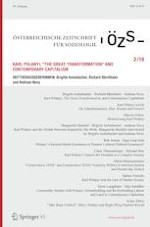01-06-2019 | Hauptbeiträge
"Conservative 1920s" and Conservative 2010s? Austerity Politics in Interwar Austria and Present-day Greece
Published in: Österreichische Zeitschrift für Soziologie | Issue 2/2019
Log inActivate our intelligent search to find suitable subject content or patents.
Select sections of text to find matching patents with Artificial Intelligence. powered by
Select sections of text to find additional relevant content using AI-assisted search. powered by
